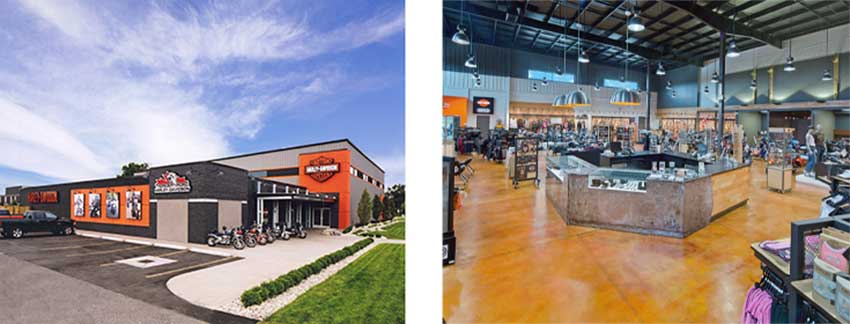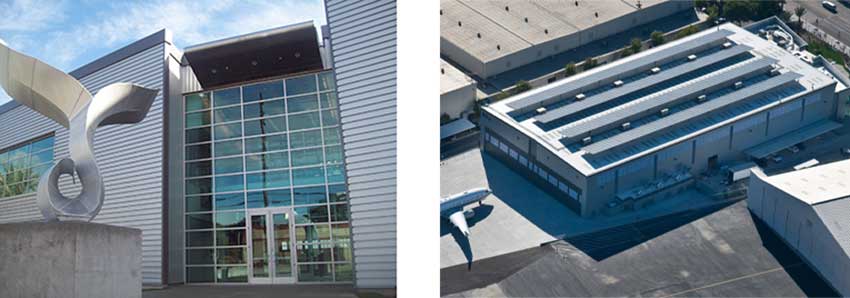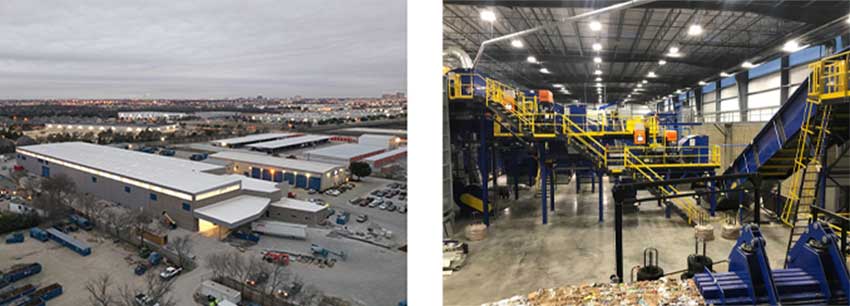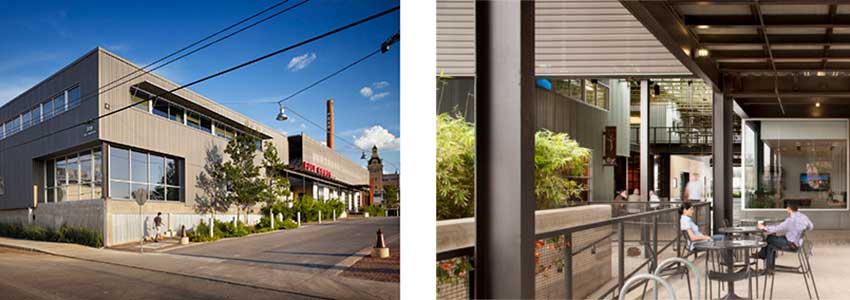Advanced Sustainability Potential Using Metal Building Systems
Sustainability and affordability come together using available technology
![]() Continuing Education
Continuing Education
Use the following learning objectives to focus your study while reading this month’s Continuing Education article.
Learning Objectives - After reading this article, you will be able to:
- Describe the latest research that affirms sustainable attributes inherent to metal building systems.
- Explore the products and processes that contribute to the sustainable attributes of metal buildings, including reductions in embodied energy and carbon.
- Determine which metal building attributes contribute to green building codes, standards, and voluntary programs, especially LEED.
- Explain how metal building energy reduction strategies directly impact operational energy use as well as opportunities for on-site solar energy generation.
The nonprofit Metal Building Manufacturers Association (MBMA) has been an advocate for consistent and continuous improvement in the efficiency and sustainability of metal buildings since the association’s inception in 1956. Recent MBMA research has advanced the engineering understanding of metal buildings in various areas including energy usage, life-cycle assessments, carbon content of products, and resiliency including resistance to wind, fire, snow, seismic events, and hail. MBMA performs this research through collaboration with many well-respected universities and credible industry leadership organizations, such as the Metal Building Contractors and Erectors Association, the North American Insulation Manufacturers Association, and the Door & Access Systems Manufacturers Association. This course explores some of the results of this ongoing work to update architects and other design professionals on the ways that metal buildings can provide very sustainable solutions in a highly customizable and affordable manner. Throughout the discussion, project examples and case studies are used to illustrate real world solutions based on the principles described. This course is an extension of two previous introductory courses on “Using Metal Buildings to Meet and Exceed the Energy Code” (AIA Course #K2012M) and “Sustainable Metal Buildings” (AIA Course #K1812J).
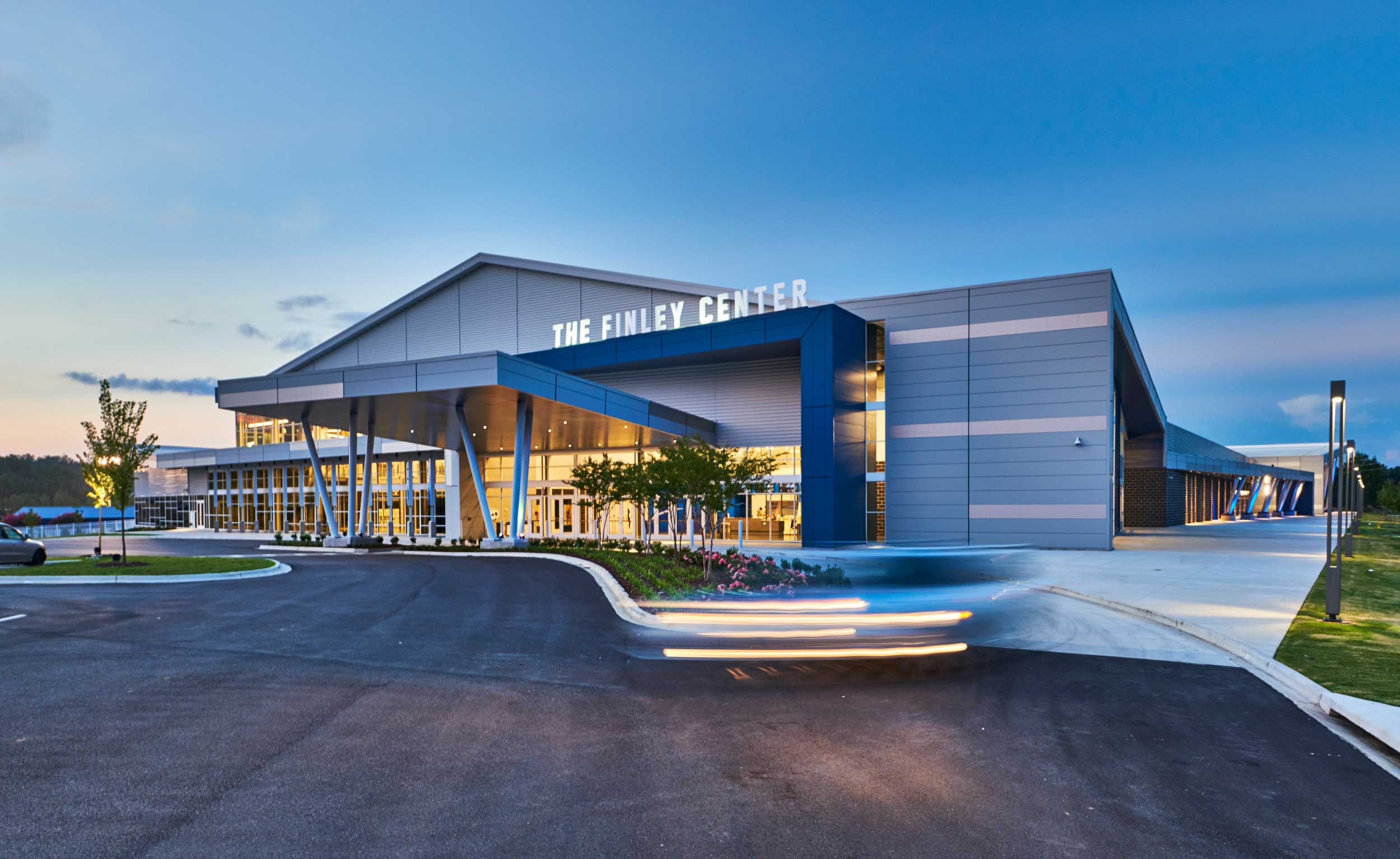
Photo courtesy of MBMA
Metal building systems are used very successfully for many building types to meet green building and sustainability goals throughout the United States and Canada.
Metal Building Systems Review
To set our context, metal buildings account for a significant percentage of all the low-rise commercial buildings constructed each year in the United States. With that in mind, it is important to remember that metal buildings take several forms.
Total Metal Building Systems
The first is a total metal building system where most (or all) of the essential structural and building enclosure components are provided by a single source—a metal building systems manufacturer. These components include the primary steel structure (columns, beams, etc.), secondary structure (purlins, girts, etc.), the wall enclosure (metal wall system or panels including inside and outside surface and insulation) and the roof system (metal roof system or panels including metal roofing and insulation).
Hybrid Metal Building Systems
The second common form of metal building combines traditional materials with metal building system components for a hybrid system. In this case, the primary steel structure and a metal roof system or panels are provided by a metal building systems manufacturer while other components or systems are provided by others. Those could include some combination of exterior and interior wall materials including concrete, masonry, wood, glass, and metal. In hybrid systems, the insulation and air sealing systems are usually provided by others as well as specified to suit a particular project design.
Significant Attributes
Regardless of the metal building type employed, all of them offer the same range of design and construction attributes:
- Flexibility: Metal building systems typically offer complete design flexibility with long clear-spans possible.
- Time Savings: Metal building systems offer faster design, fabrication, and construction process than conventional construction.
- Cost Savings: Metal building systems have consistently proven themselves to be more economical and affordable when compared to conventional construction, without sacrificing design or performance requirements.
- Sustainability: Working with a metal building manufacturer to design a custom steel structural system with a coordinated set of building enclosure components can meet or exceed high standards for sustainability in a very cost-effective manner.
- Resilience: An emerging focus is on designing and constructing buildings that are resilient, meaning they can not only survive but also bounce back quickly after a natural disaster such as wind, seismic, and flood events—or a man-made disaster, such as a chemical blast. Metal building structural systems can be fully evaluated for such events with the members, connections, and bracing designed specifically for any of the potential hazards of the project location. Since they are custom designed, specifications can include requirements that go beyond the building code to satisfy an owner’s commitment to any performance or resiliency goal.
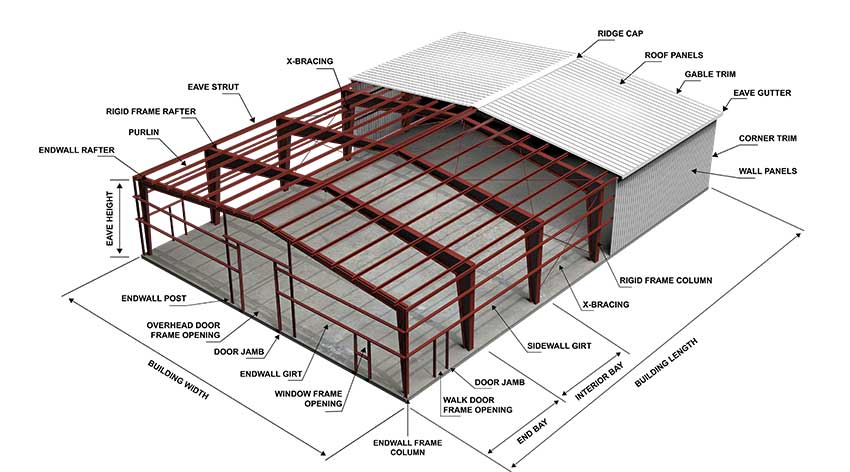
Image courtesy of MBMA
A total metal building system includes all the components for both the building structure and its enclosure.
Design and Construction Process
Sometimes there is misunderstanding or confusion about who is in control of the parts of a metal building system. In fact, they should be treated no differently than any other building. The architect is fully responsible for the building design specifications working with the building manufacturer and the general contractor. The architect’s role still includes defining the owner’s project requirements, the applicable code requirements, the size and shape of the building, and the related attributes (length, width, height, roof slope, etc.). The structural system can be laid out (column spacing, beams, etc.) in concert with input from a structural engineer (provided by either the architect or the metal building manufacturer). The specifics of the exterior also remain under the purview of the architect, including the particulars of the building envelope, such as the insulation, air sealing, cladding, and openings (doors, windows, etc.).
The architect and engineer of record usually work in tandem to determine the building’s energy code compliance pathway and the LEED certification process with input from the metal building supplier and/or general contractor as appropriate. Based on the design and basic specifications developed by the architect, the building manufacturer then provides the detailed computerized drawings or model, similar to any other structural shop drawings. Once reviewed by all and approved, then the contractor places the order for the system or components which are delivered to the site and installed quite efficiently. Note that the communication path between the architect and the metal building manufacturer is often through the general contractor. Successful projects are based on this clear and timely communication, appropriately channeled.
Based on all of the foregoing, we can look more in depth at the sustainable and green building aspects of metal buildings. In the next sections of this course, we will follow the categories for LEED first to discuss the connections between green building design and metal buildings. Following each such discussion, project examples or case studies of metal building projects are provided to illustrate how the green building design principles are achieved.
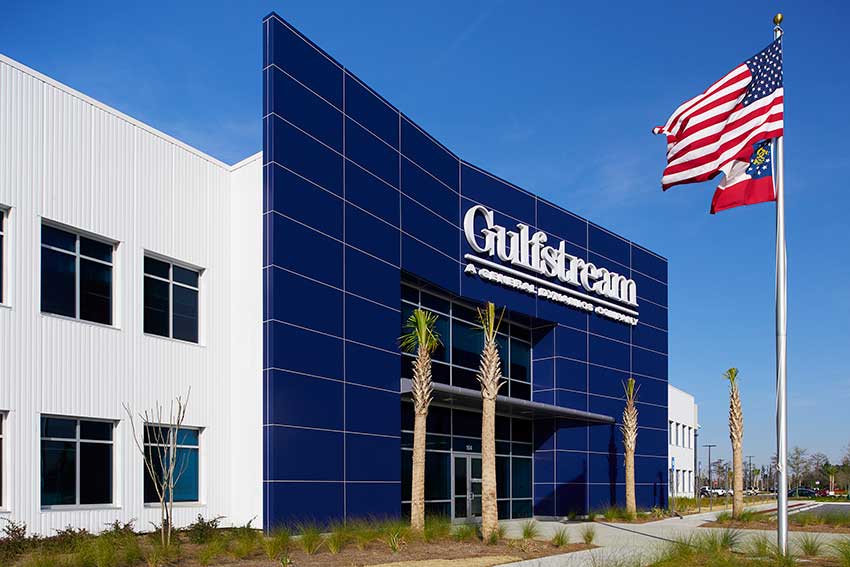
Photo courtesy of MBMA
The roles and responsibilities of design professionals are the same when creating a green, sustainable, metal building as for other building system types.
Sustainable Sites
All sites are impacted by a building being added to it—the goal is to minimize the adverse effects and maximize the benefits. Metal buildings can help facilitate both of those aims in several ways.
Site Development
Up to 2 credits are available in LEED for addressing sustainability issues in the development of a building site. Toward this end, it is helpful that metal building system components are all shop-fabricated and then erected in a controlled manner on the designated building site. This provides the ability to minimize the need to impact any site areas that are beyond the building perimeter. Further, portions of the metal building package can be sequenced to arrive as needed so that the staging area can be minimized, with reduced site impacts.
Rainwater Management
Up to 3 credits are available in LEED for addressing rainwater in natural and sustainable ways. Metal roofs provide an excellent platform to collect quality rainwater for non-potable uses. Rainwater from metal roofs tends to be cleaner and safer than water collected from other roof types, particularly those that use petroleum products.
Heat Island Effect
LEED provides for up to 2 credits based on the recognition that sunlight striking dark-colored surfaces such as roofs can contribute to “heat islands.” Hence, the use of lighter-colored roofs, particularly metal roofs, has become a common sustainability strategy. Research from the U.S. Department of Energy shows that one additional percentage of reflectivity in a roof coating, on average, will reduce roof temperature by 1 degree. A common calculation used to define a cool roof is the solar reflectance index (SRI) as defined in ASTM E1980: Standard Practice for Calculating Solar Reflectance Index of Horizontal and Low-Sloped Opaque Surfaces. SRI is a method to obtain an index for relative surface temperature with respect to a standard white (SRI = 100) and a standard black (SRI = 0) under standard solar ambient conditions and wind speed.
To determine the SRI of many materials, The Cool Roof Rating Council (CRRC) administers a Product Rating Program in which companies can label roof surface products with radiative property values once radiative roofing tests and aged field tests are conducted by CRCC approved facilities. Metal roofs (i.e., cool roofs) are ideal for reducing heat island effects with various paint coatings to achieve the intended Solar Reflectance Index (SRI) value. A lower surface temperature reduces the heat gain in the structure below. In the hottest months of the year, a standard roof surface can reach 150°F. A metal roof with a solar reflective coating can remain 50°F cooler under the same circumstances. This applies to building roof and parking lot canopies for short term and long-term SRI performance. Further, coatings that have high solar reflectance, used for both roof and wall panels, generate lower environmental temperatures which in turn lower building energy costs.
The coatings used on metal structures can also reduce smog. Catalyzers used in certain coatings use UV light from the sun and humidity from the air to break down harmful nitrogen oxides, known as NOx gases, into harmless salts.
Water Efficiency
Water use is needed in virtually all occupied buildings. Where that water comes from makes a difference. As already noted, capturing rainwater from a metal roof is a very achievable option for many buildings. That rainwater can then be stored and put to use both for outdoor and indoor non-potable water use.
Outdoor Water Use
Up to 2 credits are available in LEED to reduce potable water use on building exteriors. By developing a rainwater management program, quality, non-potable, captured rainwater may be implemented to reduce municipal water use for landscaping use.
Indoor Water Use
Since more water is often used indoors, LEED allows for up to 6 credits for demonstrating reductions in indoor water use. Here again, a rainwater management program can also be used to capture quality non-potable rainwater from a metal roof to reduce municipal water use for toilet and urinal flushing, along with some custodial uses.
Energy and Atmosphere
Energy use in buildings has been, and continues to be, one of the primary focus areas for increasing the sustainability of buildings. This includes conservation and efficiency strategies for new and existing buildings with metal buildings able to address all relevant aspects.
Optimized Energy Performance
Since a major component of sustainable green buildings is the responsible use of energy, LEED offers up to 18 credits in this category toward achieving some of those credits. Metal buildings also provide the ability to design the envelope for energy conservation and reduce energy demand. This is done through the proper levels of insulation, mitigation of thermal bridging, and controlling air leakage in opaque wall, floor, and roof areas of building enclosures. It also includes attention to details at fenestration, openings, and penetrations in these opaque areas to address the continuity of building enclosure barriers.
Energy codes provide minimum requirements for insulation in exterior walls and roofs and recognize metal building systems as a distinct construction type. However, manufacturers and architects often exceed those requirements through design decisions that promote higher levels of energy efficiency. Any of a multitude of high-performance insulation options are possible—from mineral fiber batts to rigid boards or even spray-on insulation—all of which can meet or exceed energy conservation requirements. The most commonly used insulation products for metal building systems help control condensation, thus reducing the effects of corrosion to the metal building or degradation of the insulation, all of which helps maintains overall energy performance.
Standard methods to achieve higher insulation levels have been developed for the metal building industry. Instead of using only a single layer of fiberglass insulation, it is now routine to use a double layer as recognized in ASHRAE 90.1 section A2.3.2.2: “The first rated R-value of insulation is for insulation installed perpendicular to and draped over purlins. The second rated R-value of insulation is for unfaced insulation installed above the first layer and parallel to the purlins and then compressed when the metal roof panels are attached. A minimum R-3 thermal spacer block between the purlins and the metal roof panels is required unless compliance is shown by the overall assembly U-factor.” Other options, such as foam plastic insulation may also be used whether in the form of rigid boards or spray foam in conventional or hybrid insulation manners. In some cases, insulated metal panels (IMPs) are also a very good option. This approach consists of a thermally broken panel with rigid insulation sandwiched between an inner and outer metal face that serve as interior and exterior surfaces.
In terms of coordinating energy criteria with other code requirements such as fire resistance, MBMA recently released six new UL fire-resistance-rated designs for wall-roof joints and intersections in metal buildings. These meet more stringent energy code requirements while maintaining fire safety. The new head-of-wall assemblies still call for a layer of insulation between the metal roof panels and the top of the wall, but allow for additional insulation, glass fiber, or mineral wool, as well as a vapor barrier, as found in filled-cavity insulation systems and liner insulation systems. Overall, more than 20 fire-resistance-rated assemblies are contained in the UL fire resistance directory for metal buildings. They are also available on the Fire Protection page of the MBMA website.
Using the strategies described above, metal building envelopes can be insulated at (or well above) the base-energy codes. Combined with cool roof coatings, metal buildings can fully optimize energy performance as validated through energy models. Further, HVAC systems may be downsized within a thermally efficient building to help reduce purchased energy loads.
Renewable Energy Production
In addition to energy conservation measures, LEED provides up to 3 credits for on-site production of renewable energy such as Solar Photovoltaic (PV) solar thermal systems. Such units attached to a metal roof profile provide an exceptional platform for renewable energy production. PV electric and solar water-heating systems are more economical than ever before and offer a ready opportunity to generate on-site renewable energy. Metal buildings that use standing-seam metal roofing provide an ideal platform for such systems due to the ease of mounting PV arrays and the longevity of the standing-seam metal roofing system, both of which translate to significant cost savings. Solar panels are installed on a standing-seam metal roof with clips that lock directly onto the seams and are hidden from view. The clips do not require any penetration of the roof, avoiding any potential for water seepage. Since a metal roof generally provides a service life of 60 years or more, outlasting the PV system (with a typical life of 25-30 years), their use avoids roof replacements during the tenure of most PV arrays.
Materials and Resources
The materials used in any building have an environmental impact throughout their life cycle. LEED and other sustainability programs recognize this in a variety of ways, with metal buildings consistently offering some strong solutions to reducing the impact from the materials used. Four methods are summarized in the following sections.
Building Life-Cycle Impact Reduction
LEED recognizes the value of extending the life of buildings and minimizing material impacts with up to 5 credits available. Constructing an addition onto an existing metal building or dismantling and reusing parts of the building helps achieve the Building and Material Reuse option. For new construction, the Whole Building Life-Cycle Assessment (LCA) option is ideal for metal buildings when using Whole Building LCA software like the Athena Impact Estimator software. MBMA contributed industry-wide life-cycle data with metal building specific capabilities to help design professionals achieve this credit.
The embodied carbon content of building materials has received a lot of appropriate attention recently. That’s because the majority of construction-related CO2 emissions —about 11 percent of the global total—are associated with manufacturing building materials, transporting materials to construction sites, and the actual construction process, according to a U.N. Environment Global Status report. In that light, the most obvious perceived environmental attribute of metal buildings comes from its primary material—steel. According to the American Iron and Steel Institute (AISI) and the Canadian Sheet Steel Building Institute (CSSBI), steel is the most recycled material in North America. By specifying recycled steel, which is often processed in an electric arc furnace, the emissions and embodied carbon content of the steel is greatly reduced.
To understand the relative significance of using recycled steel metal buildings, a life- cycle assessment comparison of buildings with different structural and envelope materials was produced independently by the engineering firm of Walter P. Moore & Associates. The resulting report concluded that “Metal buildings showed lower environmental impacts in all six metrics when comparing structural and envelope materials to load bearing masonry walls, concrete tilt-up, and steel framed construction of the same building footprint and functional equivalence.” Further, with all metal building components typically delivered simultaneously from the manufacturing plant to the construction site, emissions related to material delivery are vastly reduced over other forms of construction.
Building Product Disclosure and Optimization—Environmental Product Declarations (EPDs)
Environmental Product Declarations (EPDs) are widely recognized as the best way to communicate the environmental impacts of building products. LEED recognizes and encourages their use, with up to 2 credits available in this category. In support of the creation of these documents, the MBMA funds extensive research related to the environmental impacts of metal building systems. Through collaboration with the Athena Sustainable Materials Institute and UL Environment, MBMA developed an industry-wide LCA report and three industry-wide environmental product declarations (EPDs) for designers to use when specifying MBMA-member products. These are available to architects and others for download at mbma.com.
MBMA also recently released revised environmental product declarations (EPDs) for three specific metal building product categories: primary rigid framing, secondary framing, and metal cladding for roofs and walls. These provide architects, specifiers, designers, and other industry professionals with transparent, third-party documentation of the environmental impacts of products used in metal building systems. MBMA partnered with UL Environment to develop and certify these EPDs which summarize the cradle-to-gate environmental impacts of a metal building system. The EPDs are based on Product Category Rules (PCRs) used to develop a life-cycle analysis (LCA) final report, which is summarized in the EPDs. Significant improvements were noted in the most recent EPDs over the previous ones developed using the same process. For example, the use of recycled steel has improved by 20 percent and the scrap produced has dropped 15 percent. The MBMA industry-wide LCA Final Report and the three MBMA industry-wide EPDs conform to ISO 14044 and ISO 21930, with the cradle-to-gate scope to help earn credits.
Building Product Disclosure and Optimization—Sourcing of Raw Materials
The sourcing of raw materials is a significant concern with up to 2 credits available in LEED to address this. Toward that end, metal building manufacturers' lists may provide the information to meet the Raw Material Source and Extraction Reporting option. The Leadership Extraction Practices option includes the list of traditional single-source attributes, such as recycled content, materials reuse, etc. The recycled content is a strong point for metal building construction. Steel is the only material with the approved default recycled content of 25 percent. Many steel producers and metal building manufacturers publish their true recycled content to increase the percentage for calculation purposes.
Some related points here, include the following:
- Metal buildings are generally manufactured from at least 65% recycled steel, substantially reducing the need for virgin materials excavated from the earth. Then, at the end of a building’s life, the raw steel can be 100% recycled to be used in various products, such as cars, appliances, buildings, and bridges.
- Steel’s recyclability exceeds other comparable construction materials and its contribution to a circular economy is increasing. Steel products are becoming more lightweight and designed for diverse applications and extended useful life. In particular, metal buildings are more lightweight (use less material) than other forms of steel construction and as a result have less embodied carbon than many competing forms of construction.
- New steel, made with recycled material, uses as little as 26% of the amount of energy required to manufacture steel from iron and other naturally extracted materials.
- Steel can be continually recycled into new steel products without any deterioration in product quality.
- Net-zero carbon steel, manufactured in the US, provides emissions-free steel products to help architects meet their sustainability goals. It is also important to note that, today, the United States is the cleanest place in the world to make steel, accounting for less than 2 percent of the GHG emissions from the global steel industry. The AISI points out that steel source energy is increasingly from electricity, with more of that electricity coming from renewables than previously.
Construction and Demolition Waste Management
Building construction and demolition generally produces a lot of on-site waste, which is why LEED offers up to 2 credits to reduce and manage it. It is advantageous, then, that all the components of a metal building system are custom designed and efficiently fabricated in an off-site, controlled environment. They are then delivered to the site according to a pre-determined construction schedule. That means there is no extra material sent to the construction site with very little, if any, field cutting required. In fact, metal buildings typically generate more than 50 percent less job-site waste than other construction approaches. In most cases, they have readily achieved the LEED credit for Option 2—Reduction of Total Waste Material—generating no more than 2.5 pounds of waste per square foot of a building’s floor area.
Indoor Environmental Quality
People spend most of their time inside buildings, including metal buildings. The quality of their indoor experience, including impacts on their health and well-being, is directly related to the quality of the indoor environment. In that regard, sustainability and green building have always included a focus on this critical part of building design, including the following aspects.
Low-Emitting Materials
Emissions of volatile organic compounds (VOCs) inside buildings has been documented to be detrimental to human health, both in the short term and long term. Therefore, LEED offers up to 3 credits to reduce or eliminate VOCs and other substances from buildings, particularly as found in painting, adhesives, coatings, etc. Metal building components typically have coatings and paint applied to the steel off-site in a controlled fabrication facility. Therefore, they do not affect the VOC calculations within this credit. More importantly, VOC emissions from painted or primed metal building components are very limited, thus helping to avoid human exposure to these compounds.
Daylight
Daylight has been found to provide significant health benefits, both physical and mental health. Because of the compelling nature of this aspect of green buildings, LEED offers up to 3 credits for buildings that provide natural daylight to occupied areas of buildings. Designing metal buildings to incorporate daylight to help achieve this credit is readily possible with a variety of design approaches using windows, sidelights, and skylights. A common metal building product also includes light-transmitting, translucent panels installed on the metal roof or wall area. Any of these strategies may also include diffusers to enhance the light distribution and light quality.
Looking a little further into this topic, customizable fenestration is an important attribute in the design of metal buildings just as it is for any occupied structure. All buildings need fenestration openings for egress, light, and ventilation. However, providing those openings in a manner that is sustainable is a function of controlling the things that pass through them. While it is important for windows, doors, and skylights to admit light, it is equally important to restrict solar heat gain when air-conditioning is in use. Conversely, heat loss and air infiltration through fenestration are energy concerns when the building is being heated. Proactively, the fenestration industry has developed products with performance characteristics related to overall thermal U-factors, solar heat gain coefficient (SHGC), visible light transmission (VT), and air infiltration. These commercial products can be readily incorporated into metal buildings, and, in some cases, the metal building manufacturers offer their own customizable products in the form of windows, skylights, and translucent wall and roof panels.
Innovation in Design
Sustainability usually involves innovation—thinking beyond the customary or the norm to achieve the desired outcome or results. LEED can seem rather prescriptive to some, but its intent was never to limit creativity or innovation. As such, there are multiple credits available for innovation and creative ways to achieve more sustainable and well-designed buildings. Some LEED innovation credits rely on showing how a particular design exceeds the minimum requirements to earn a credit. It should be clear by now that metal building systems have advantages that can certainly help in that regard. There are also other ways to incorporate innovation, and the design flexibility, customization, and affordability of metal building systems certainly help in that regard as well. Even if a particular innovation doesn’t fit into a category to achieve an additional credit, the net result for the building can still be quite positive to benefit the owner, the users, and the environment.
Conclusion
Metal buildings have been shown to be a preferred way to design and construct green and sustainable buildings in all parts of the country. The design is fully flexible, customizable, and economical with metal building systems proving to be applicable to any type of commercial, industrial, or institutional low-rise building. They have also been shown to contribute very significantly to earning credits under the LEED green building rating system. For more information or to see any of the resources described in this course, you can refer to the MBMA website at https://MBMA.com.
Peter J. Arsenault, FAIA, NCARB, LEED-AP is a nationally known architect and a prolific author advancing sustainable buildings through better design. www.pjaarch.com, www.linkedin.com/in/pjaarch




